Pinnacle Systems Hollywood FX - 6.0 User’s Guide
Introduction
Thank you for purchasing Pinnacle Systems’ HollyÂ-wood FX. Hollywood FX is a powerful editor of 3D transitions, titles and animated effects. Since 1994 this product has provided many of the same capabilities as broadcast television equipment and high-end compositors. It gives you an incredible collection of 3D transitions that you can quickly add to your video productions, and completely customize to your needs. The topics below will introduce you to Hollywood FX, provide instructions for installation and give contact information for customer support.
This is a general guide to using Hollywood FX. If you received Hollywood FX as part of a complete Pinnacle Systems’ solution, you should first read the Hollywood FX
documentation accompanying that solution. ð What is Hollywood FX?
ð Hollywood FX levels ð Before you start
ð Installing Hollywood FX ð Licensing and registration ð Customer support
Page 1
What is Hollywood FX?
Hollywood FX is an incredible collection of true 3D transitions and effects that you can add to any video production. Hollywood FX works as an integrated plugin to your video editing software (the “host application―). Hollywood FX is:
·
True 3D: Hollywood FX uses OpenGL to provide hardware accelerated, high quality 3D rendering. ·
Easy to use: Simply drag-and-drop Hollywood FX into your timeline like any other transition or filter. The Hollywood FX window will appear and you can select a transition, change your options, or customize an effect.
·
Organized: Transitions are organized into conveniÂ-ent bin categories with icons that let you find the transition you want quickly.
·
Convenient: With every transition you can quickly change the flight direction, lighting, shadows, shine and antialiasing with the click of your mouse.
·
MultiWindow excitement: Hollywood FX supÂ-ports unlimited video sources to create multi-layer 3D composites. Create cubes with different video sources on each side, and much more.
·
Expandable: Additional theme packs of 3D transitions, effects, plug-ins and more are available through Pinnacle Online, and Hollywood FX PRO lets you share your own creations with other users. Visit Pinnacle Online at:
hollywoodfx.pinnaclesys.com
Page 2
Hollywood FX levels
There are two levels of Hollywood FX for Edition:
· Plus: This version is included with Edition 5 and includes 300 FX plus advanced control over lighting, light direction, shadows, shine, motion blur, trails, antialiasing and more. Plus
lets you customize any transition with full keyframe editing of flight paths, object shape (morphing) and transparency of objects.
· PRO: Gives you more than 100 additional transitions (over 400 total) and gives you complete control over all 3D rendering options. PRO
provides a complete suite of 3D tools to create your own 3D transitions and effects: ·
Complete keyframe editing of all object, surface, light and camera attributes in a full 3D editing environment.
·
Includes a suite of image filters including: Blurs, Directional Wipe, Edge Wipe, Gradient Wipe and Luma and Chroma key.
·
Includes a powerful suite of 3D warp plugins including: Alpha Particles, Displace, Explode, Peel, PolyShrink, Swirl and Twirl.
·
Adds an incredible 3D text generator that lets you create amazing 3D text fly-ons. ·
Import your own 3D objects (Lightwave 5 format) to create completely unique 3D effects. ·
Share your customized effects with others by exporting a simple self-installing compressed file that contains the effect and all objects and images needed for that effect.
You can easily and instantly upgrade between these levels over the Internet at Pinnacle Online or purchase packaged upgrades from your video reseller.
This is a complete guide for both the Plus and PRO levels of Hollywood FX. Sections and features only available in PRO are marked with
PRO .
Page 3
Before you start
Before getting started with Hollywood FX you should have a good working knowledge of your Windows system. You should be able to use the mouse to select menu options and should understand and be able to use the common controls.
You should also be thoroughly familiar with your video editing software. You should be able to use clips in the timeline and understand how to add and modify transitions and filters.
Throughout this document we use the term FX
to refer to the transitions and effects in Hollywood FX. This term generically describes the following types of transitions and effects:
·
Transition: These are standard A-B transitions, where one video source transitions into a second.
· Transition+: These are also A-B transitions; however, they may have additional video channels that can be mapped with video. For example, the FlipOver FX
features the first video source flipping over like a card to reveal the second video source. There is a third video source that is visible in the background as the “card―flips over.
·
MultiWindow: These effects are not transitions at all. Instead, windows of video may fly on or off the screen into various positions while playing your video.
·
AniComps: These are effects that frame a picture, provide 3D titles and accentuate a video segment through animated composites.
Page 4
Installing Hollywood FX
If Hollywood FX was included in a Pinnacle Systems’ solution, it will be installed automatically with that product, and you can skip this section.
Before installing Hollywood FX, verify that you have the correct minimum requirements: ·
PC-compatible computer with at least a 300 MHz (Intel Celeron/Pentium II, or AMD Duron/Athlon class processor).
·
Windows 98 Second Edition, Windows ME, Windows 2000, or Windows XP. ·
64 MB RAM (more may be required by your video editing software). For multi-window effects, 128 to 256 MB (or more) is recommended.
·
At least 200 MB hard disk space. ·
16-bit or 24-bit display adapter. A 3D OpenGL accelerator is recommended. To install Hollywood FX:
1.
Insert the Hollywood FX CD into your CD-ROM drive. The main installation menu for your software will appear.
2.Select Install Hollywood FX
. The Language Selection dialog will appear.
3.Select your preferred language then click OK
. The Serial Number dialog will appear.
4.Enter the serial number that came with your software (normally found on the first page of this guide or on the CD-ROM sleeve). Enter the serial number exactly as shown, including dashes, then click
OK
.
5.Click Next
to continue. The Setup Path dialog will appear.
Normally you should accept the default path for installation. Do not select your non-linear editor’s plug-in path for installation; the installer will automatically install the files needed into your non-linear editor’s folders. Click Next
to continue. Hollywood FX will be installed on your system.
After installation, the LicenseTool dialog will appear. You have the option to register online immediately (see Licensing and Registration
).
After installation, you may be required to restart your system.
Page 5
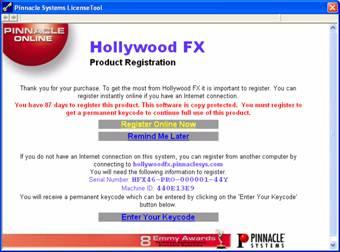
Licensing and registration
The License Tool
Registering your software gives you access to important benefits including current updates, support, upgrade promotions, and information on exciting new products from Pinnacle Systems. Hollywood FX Basic and Plus
do not require registration, but will continue to remind you until you have registered your software. Hollywood FX PRO is copy protected, and users must
register within 90 days to continue using the software.
When you register a Hollywood FX product, you will receive a permanent keycode that fully enables Hollywood FX on a particular computer and stops the registration reminders.
You can register from any Internet-enabled computer by connecting to hollywoodfx.pinnaclesys.com
. If you do not have your own Internet-enabled computer, you can register from any computer that is connected to the Internet (from a library or Internet café for example).
If you reformat your system drive and reinstall the operating system or move Hollywood FX to a new computer, you will need a new permanent keycode, which you can obtain at hollywoodfx.pinnaclesys.com
.
Page 6
Customer support
Pinnacle Systems is dedicated to providing the best products and the best customer support. For fastest support, point your browser to:
http://www.pinnaclesys.com/support
Please note: Pinnacle Systems cannot provide support for using your non-Pinnacle video editing software. You should first make sure you fully understand the operation of your other software before calling. You should also look through the read-me file and the Troubleshooting
section of this guide before contacting customer support.
Page 7
Getting started
The topics linked below will help you get started using Hollywood FX in Pinnacle’s Edition and Liquid – the “host applications―.The basic procedure for adding and modifying Hollywood FX transitions and filters is described, along with hints and tips.
After this brief introduction, first-time users should continue with the tutorials
.
ð Hollywood FX in the application ð Adding a Hollywood transition
ð Changing an existing HFX transition ð Using Hollywood FX as a filter
Page 8
Hollywood FX in the application
The Hollywood FX effects can be found and inserted into a host application project in various ways. One way is by selecting the ALL button just below the central bar. This will reveal the tree of various filters and plugins offered. From here you can either select the primary Hollywood FX icon from the PlugIn Transition FX if you want to use an FX for transitions. To use an FX as a filter, select the Hollywood FX icon from Plugin Clip Fx
.
Another way is under RealtimeTransition FX/Specials
. Here, every transition has its own icon that you can simply drag and drop it between two video sources.
Page 9
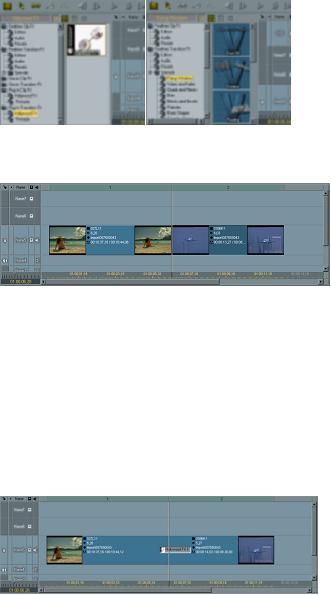
Adding a Hollywood transition
Multiple ways to select a Hollywood FX
Before adding a Hollywood FX transition, prepare two video sources on the A and B tracks of the timeline, so that there is some overlap between the two video clips.
Timeline prepared for Hollywood FX Transition
To add a transition to the timeline:
1.Click on the Edition.FX tab in the Project window, then double-click on the Plugin Transition FX folder, and the Pinnacle
group.
2.Drag Hollywood FX
from the Project window into the timeline, between the two video clips.
3. Double-click on the transition block or Right-click on the transition and choose the Edit
... command from the popup menu.
The Hollywood FX dialog will appear, letting you choose a specific transition, and change options for your transition.
A Hollywood FX Transition in the timeline
Page 10
Changing an existing HFX transition
You can modify a transition that is already in the timeline, changing the selected effect or any options at any time.
To change an existing transition in the timeline:
· |
Double-click on the transition block; or |
, |
Right-click on the transition and choose the Edit |
· |
... command from the popup menu.
The Hollywood FX window will appear, letting you choose a specific transition, and change options for your transition.
Page 11
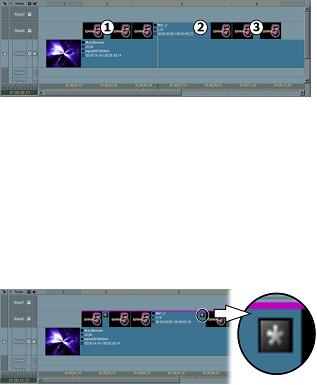
Using Hollywood FX as a filter
Hollywood FX can be used as a filter on a graphic, title, or video clip. Hollywood FX is great for flying on or off titles over video.
To prepare: 1.
Start a new sequence and drag a video clip into the first video track.
2.
Select a title and drag three copies of it into the timeline, on the video track immediately above the video clip you dragged into the first track.
The Timeline, ready for a Hollywood FX Filter. (1) The first copy of the title will fly on over the video clip; (2) The second will simply be overlaid on the clip; and (3) The third will fly off the screen.
To fly on the title with Hollywood FX:
1.In the Project window, click on the Edition.FX tab, then double-click on the Plug In Clip Fx folder.
2.Drag the Hollywood FX 5.0 Filter
from the Project window into the timeline on top of the first copy of the title.
3.Double-click on the asterisk (
) icon on the title clip to display the Hollywood FX window.
The Hollywood FX Filter has been added to the first title clip. Double-click the icon (circled) to display the Hollywood FX dialog. Right: The icon is shown in a magnified view.
4.Click on the Domino
effect in the first row of the FX Album.
5.Click on Basic Options
in the Properties panel on the left.
6.Check the Reverse Flight
checkbox (this will make the effect fly on instead of fly off).
7.Click OK
to close the Hollywood FX window.
After background rendering is complete, you can play the sequence back and see the title fly on with the effect selected.
To fly off with Hollywood FX:
1.Drag the Hollywood FX 5.0 Filter from the Project window into the timeline on top of the last copy of the title.
2.Double-click on the asterisk (
) icon on the title clip to display the Hollywood FX window.
3.Select the Dive Off
effect from the first row of the FX Album.
4.Click OK
to close the Hollywood FX window.
Page 12
When background rendering is complete, you can play the sequence back, and you will now see the title fly on, hold, then fly off.
Page 13
Tutorials
Here we present three tutorials that will help you get oriented quickly to using Hollywood FX. Each tutorial focuses on a different FX
type: Transitions, Transitions+ and MultiWindow. ð Tutorial 1: Transitions and options
ð Tutorial 2: Transition+
ð Tutorial 3: MultiWindow FX
Page 14
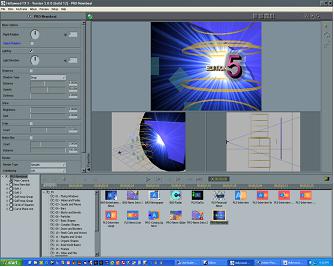
Tutorial 1: Transitions and options
This tutorial will take you through the basics of selecting a Transition FX and setting Effect Options.
To prepare for this tutorial: Set up two video clips in your host application and add Hollywood FX as described in Getting Started
. When the Hollywood FX window appears, you are ready to begin.
The Hollywood FX window
The Hollywood FX window is organized into panels and menus. The first panel is the Properties
panel (by default this panel may be closed upon first use after install). This is where all detail controls are found.
The second panel is the Monitor panel that displays the preview of the current FX (the above image shows the monitor selected in Tri-View mode).
Finally, the lower half provides access to the Album folders. One is for selecting property controls for Objects, Plug-ins, Media, Camera and Lights. The other is for selecting from the many categories of FX
.
ð Tutorial 1.1: Selecting an FX ð Tutorial 1.2: The Monitor panel ð Tutorial 1.3: Basic effect options ð Tutorial 1.4: Basic flight options
ð Tutorial 1.5: Basic lighting, shadows and shine ð Tutorial 1.6: Basic render options
Page 15
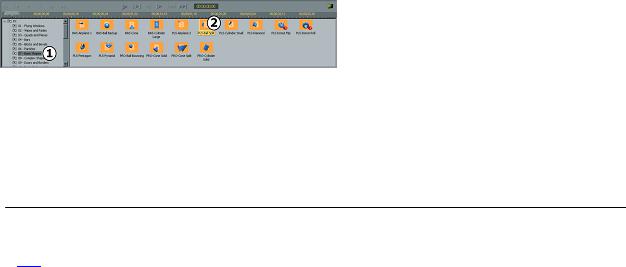
Tutorial 1.1: Selecting an FX
When the Hollywood FX window is displayed, you will immediately see the FX Album Folders (the FX you chose and the FX Folder it is a part of should be highlighted). The FX Album has two major panels: the FX Album Folder tree showing the different FX Folders and the panel showing the FX Album Items of the FX Folders allows you to select one of the many FX available. For this tutorial you will select an interesting transition called Ball Split. This FX is in the Basic Shape
group.
Selecting a folder (1) and an item (2) in the FX Album. To select the Ball Split FX
:
1.Select Basic Shapes from the FX Group popup list.
2.Click on the Ball Split FX
icon.
ð Forward to Tutorial 1.2 ð Up
to Tutorial 1
Page 16
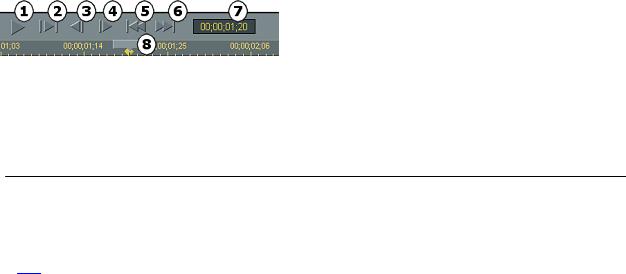
Tutorial 1.2: The Monitor panel
Whenever you make changes in Hollywood FX, the preview window in the Monitor panel is updated. Try dragging the slider directly below the preview to view different frames of the preview.
Monitor panel: 1) Play entire FX preview once; 2) Loop play: preview continuously as you work (press again to stop preview); 3) Step backward one frame; 4) Step forward one frame; 5) Go to first frame; 6) Go to last frame; 7) Frame counter; 8) Timeline slider.
To turn on continuous playback of the preview: click on the Loop Play button below the preview window in the Monitor
panel.
ð Back
to Tutorial 1.1 ð Forward to Tutorial 1.3 ð Up
to Tutorial 1
Page 17
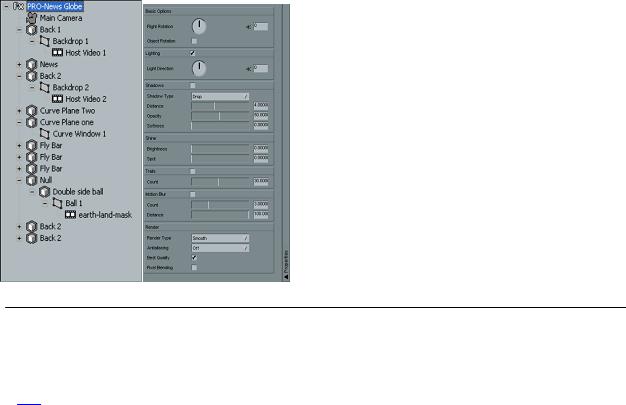
Tutorial 1.3: Basic effect options
Hollywood FX gives you quick and easy control over many FX options. You can create new and exciting results without having to re-keyframe the entire FX
.
To view the basic effect options: Click on the name at the top of the FX Tree
.
Left: The FX tree. Right: The Basic Options selected in the Properties Panel.
ð Back
to Tutorial 1.2 ð Forward to Tutorial 1.4 ð Up
to Tutorial 1
Page 18
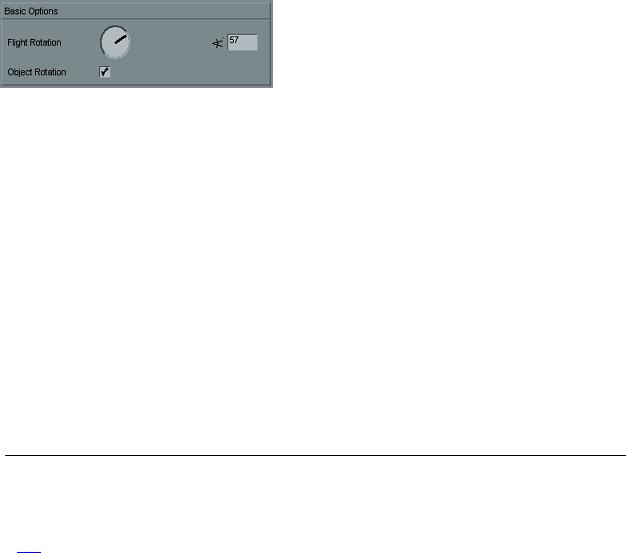
Tutorial 1.4: Basic flight options
You can quickly change the flight path of an object in useful ways using the Basic Options controls.
Basic flight options
Watch the preview now. You will see that instead of the first video source flying off and revealing the second video source, the second video source will fly on and cover the first video source.
Flight path try-out:
· |
Click-and-drag the Flight Rotation dial so that it reads 45 |
. Watch the preview. |
|
· |
Click on the Object Rotation |
checkbox so it is checked. Watch the preview. |
|
· |
Click-and-drag the Flight Path dial so that it reads 90 |
. Watch the preview. |
|
· |
Click-and-drag the Flight Path dial so that it reads 0 |
. You can also use the arrow keys to change the dial by one degree increments. The Flight Path dial rotates the entire flight path of the 3D objects in the FX
, giving you a different result quickly and easily. When you change the Flight Path, it does not rotate the object itself. Checking the Rotate Object checkbox will cause the object itself to rotate and “follow― the new path.
Note: Some FX
were not designed to be compatible with the basic flight options. So this feature may be disabled for those effects.
ð Back
to Tutorial 1.3 ð Forward to Tutorial 1.5 ð Up
to Tutorial 1
Page 19

Tutorial 1.5: Basic lighting, shadows and shine
Lighting, shadows and shine add incredible 3D realism to an FX
. By default all of these features are turned on. Try turning them off to see the difference it makes.
Basic lighting options
Basic shadow options
Basic shine options
To turn off Lighting and Shadows:
· |
Click on the Shadows |
checkbox to clear it. Notice that the shadow disappears. |
|
· |
Click on the Lighting |
checkbox to clear it. Notice that the 3D ball is no longer shaded. |
|
· |
Click on Shadows and Lighting |
to turn these features back on. |
|
In addition to being able to control which lighting features are used, you can also control the light direction. By default, light comes from the top center of the 3D “worldâ€.•When you adjust the light direction, it automatically adjusts the shine and shadow position as well.
Light direction try-out:
· |
Click-and-drag the Light Direction dial so that it reads 90 |
. Watch the preview. |
|
· |
Click-and-drag the Light Direction dial so that it reads 180 |
. Watch the preview. |
|
· |
Click-and-drag the Light Direction dial so that it reads 0 |
. You can also use the arrow keys to change the dial by one degree increments.
Changing the light direction to 180 degrees gives a very unique, almost sinister appearance.
ð Back
to Tutorial 1.4 ð Forward to Tutorial 1.6 ð Up
to Tutorial 1
Page 20
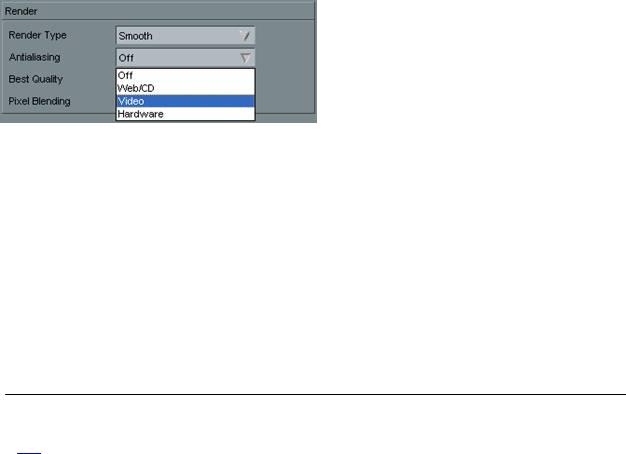
Tutorial 1.6: Basic render options
The Basic Options Render controls let you adjust special rendering features of the 3D engine. Render type
Normally objects with curves are rendered with smooth surfaces. You can use the render type to change to faceted or wire surfaces.
To change the render type:
· |
Select Flat from the Render |
dropdown. Notice that the object no longer appears smooth. |
|
· |
Select Wire from the Render |
dropdown. Notice that the object is now rendered as a wire-frame rather than a solid object. · Select Smooth from the Render
dropdown to return to smooth solid rendering. Antialiasing
Because of the low resolution of video, sharp edged 3D effects will often exhibit blocky stairstepping along the edges of objects. Antialiasing eliminates much of this problem. Hollywood FX includes three methods of antialiasing (although the preview generally displays only edge antialiasing).
Selecting render options Antialiasing first look:
· Select Web/CD under Antialiasing
and notice how the edges of the 3D ball are smoothed. · Select Video under Antialiasing
to switch to scene antialiasing. This generally will not change the preview, but during final rendering full Scene antialiasing will be used.
· Select Hardware under Antialiasing
to take advantage of some of today’s high-end graphics chips.
The additional checkboxes and advanced shadow controls are described in more detail under Quick Lighting Controls
.
When you are ready, click OK
in the Hollywood FX dialog to exit, then render your project to see the results.
ð Back
to Tutorial 1.5 ð Up
to Tutorial 1 ð Forward to Tutorial 2
Page 21
Tutorial 2: Transition+
In Tutorial 1 you worked with a Transition FX that had only two video sources. In the present tutorial you will use a Transition+ FX
that also performs a transition but has additional video sources you can use. When you are finished with this tutorial, you will know:
· How to use a Transition+ FX with extra video sources.
·
Some of the features on the Settings menu.
To prepare for this tutorial: Set up two video clips in your host application and add Hollywood FX as described in Getting Started
, creating a two-second transition. When the Hollywood FX window appears, you are ready to begin. ð Tutorial 2.1: Selecting the Transition+
ð Tutorial 2.2: Mapping a video clip to Source 3
Page 22

Tutorial 2.1: Selecting the Transition+
To select the transition:
1.Select Wipes and Fades
from the FX Group popup list at the top of the page.
2.Click on the FlipOver
icon.
3.Click the Play Once preview button on the Monitor
.
Watch the preview. Notice that while the video is flipping over, you can see black in the background. There is a backdrop that is currently not visible, because no video source has been mapped to it. The next step is to map that third video source
.
ð Forward to Tutorial 2.2 ð Up
to Tutorial 2
Page 23
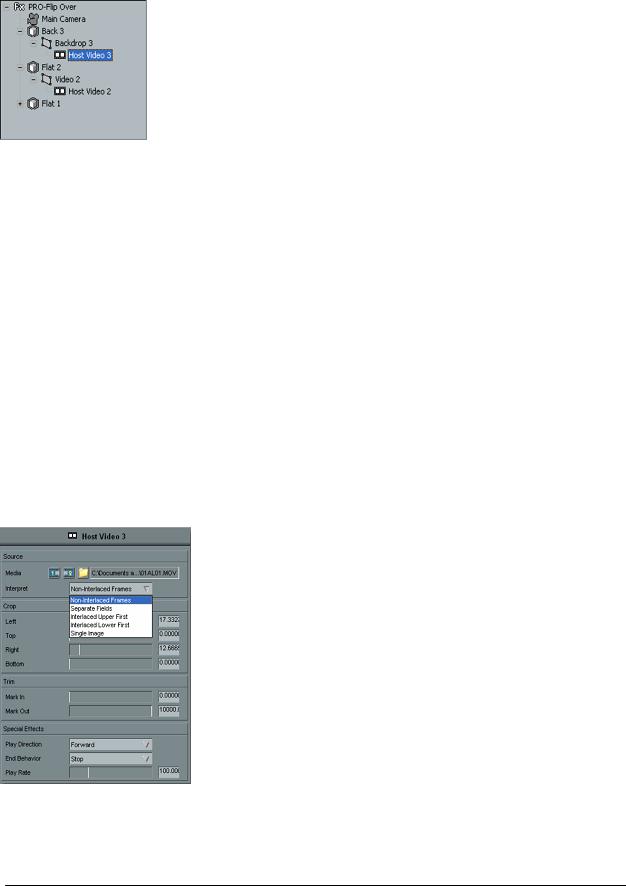
Tutorial 2.2: Mapping a video clip to Source 3 Continuing Tutorial 2
, we will now add a video clip to Source 3 so that the background is no longer black.
Selecting media options
To add a video clip to Source 3:
1.Double click on the Back 3 Object icon in the
icon in the Tree panel.
Tree panel.
2.Double click on the Backdrop 3 Surface  Icon to expand out the Media
Icon to expand out the Media 
file.
3.Click on the Select File
button in the Media Options panel. 4.
Using the file requester, select a video clip to use for Source 3. 5. Click on the Play Once
button in the Monitor window.
You have selected a new video source and should be able to see it in the background as Source 1 flips over to Source 2. You should also make sure the field interpretation is correct for this video.
To change field Interpretation: Click on the Interpret popup, and select the proper field interpretation for your video. For most video capture cards you will select Interlaced – Upper First or Interlaced
– Lower First.
While correct interpretation is not important in the preview, it will be important for final rendering. If interpretation is not set correctly, the video in the background will playback incorrectly (it will jitter rather than playing smoothly).
Media Options panel, showing the Interpret field
From now on, when you select a video file, the Interpret value will be defaulted to the last option selected. You will only need to change Interpret if you select a single image file, or video captured using a different video card.
ð Back
Page 24

to Tutorial 2.1 ð Up
to Tutorial 2 ð Forward to Tutorial 3
Page 25

Tutorial 3: MultiWindow FX
Tutorials 1 and 2 introduced you to Transition and Transition+ FX respectively. The third type of FX in Hollywood FX is the MultiWindow FX. MultiWindow FX do not perform a transition from one video source to another. Instead, they feature multiple video windows that fly on or off screen in various ways. For this tutorial we will use the Flip 4
effect, where four video windows fly off after playing over a backdrop. Prepare for the tutorial
MultiWindow FX are designed differently from Transitions. In a MultiWindow FX, the Source A video from the host application is always used as the backdrop video. This makes it easy to lay out the timeline so that you can have the backdrop video continue before or after the FX
.
To prepare for the tutorial: 1.
Start a new project.
2.
Place the video you want to use as the backdrop on video track 5, so that it starts at the beginning of the project, and runs for about five seconds.
3. Insert the Hollywood FX filter plug-in from the Plug-In Clip FX onto the video in Track 5.
4.
Double click on the asterisk next to the thumbnail at the end of the video clip to open the Hollywood FX window to select the effect.
The Hollywood FX transition in Edition, ready for a MultiWindow FX. 1) Drag and drop the Hollywood FX filter from the Plug-In Clip FX; 2) Place the filter on this video, as it will be the backdrop for the FX; 3) Double-click asterisk here to open Hollywood FX.
ð Tutorial 3.1: Selecting the FX and setting options
Page 26
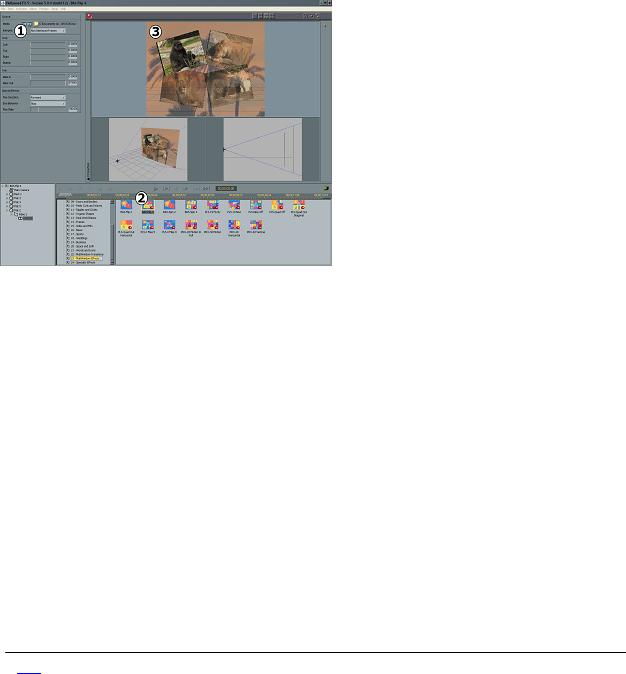
Tutorial 3.1: Selecting the FX and setting options
To select the Flip 4 FX and set options:
1.Select Multiwindow Effects from the FX Album.
2.Select Flip 4
from the FX icons.
3. Click on the Play Once button in the Monitor panel.
Notice that the video source from the timeline plays in the background. We will now select video clips for the remaining video windows.
The Hollywood FX transition selected and ready to map additional video. 1) Select folder to map additional sources; 2) Selected FX – Flip 4; 3) How Flip 4 should look after mapping additional sources.
To map the additional video sources:
1.Click on the FX Tree panel.
2.Click on the Flat 3 object.
3.Click on the Host Video 3  to reveal the Media Properties panel.
to reveal the Media Properties panel.
4.Click on Select Media File folder in the Properties
panel.
5.
Select a video clip using the file requester.
6.Now you’re ready to do the same for the other Host Medias, except for Back 1
.
7.Click on the Play Once
button in the Monitor panel to see the preview.
Because you set up the default Interpret value in Tutorial 2
, you should not have to change it for each video source you selected above.
ð Up
to Tutorial 3
Page 27
Pinnacle Online
When you register Hollywood FX online to get your permanent keycode, you will also receive a userid and password for Pinnacle Online, where you can purchase and instantly download upgrades and add-on packs of FX
.
To use Pinnacle Online you will need a web browser (like Microsoft Internet Explorer 5.0 or higher), and a connection to the Internet. Simply connect to:
http://hollywoodfx.pinnaclesys.com
Follow the instructions there to access and use your Pinnacle Online account.
Page 28
Troubleshooting
This section provides a list of common problems and their solutions. If you can’t find an answer to your problem in this list, or in the ReadMe file that is created during setup, then contact Hollywood FX customer support
for more help.
Hollywood FX does not show up in my host application.
During installation Hollywood FX will attempt to find all compatible host applications and install the proper plug-in files for each. If Hollywood FX does not show up in Pinnacle Edition/Liquid, try copying the plug-in files from the Host Plugins folder (in Hollywood FX
) as follows:
· Copy Edition\HfxEdt5.vfx to:
Edition\Plugins\Transitions
· Copy EditionFilter\Fl-HfxEdt5.vfx to:
Edition\Plugins\Filter
My video editor crashes when I try to use Hollywood FX.
This usually indicates a conflict with your 3D graphics card. You should download and install the very latest drivers for your graphics card.
I never get a rendered transition, I just get the Hollywood FX Logo.
This indicates that Hollywood FX was not able to use OpenGL to render the effect. Check the following items to resolve this problem:
· Check to make sure the files Opengl32.dll and Glu32.dll are in your Windows\System folder (
Winnt\System32
). If they are not present, Windows 95 users should download the OpenGL libraries from the Support area of the Hollywood FX website. Windows 98, NT, and 2000 users should check their operating system installation, and reinstall any service packs.
·
Make sure you are using the very latest drivers for your graphic display card. · Change the preview engine under Render Engine in the Preview
menu.
When I select video or images in the Media Options panel I get a white object instead of video. Generally this indicates you have run low on memory. If you are doing MultiWindow effects with more than 3 video sources, you should have a minimum of 128 MB of RAM (with at least 256 MB highly recommended). If you are using images you scanned in, you should lower the resolution of those scanned images.
I get color/brightness jumps at the start and end of my effect.
This is normally because the rendered effect is being recompressed while the surrounding video is not. Many non-linear editors have an option to Recompress Always or to turn off Smart Rendering. If your non-linear editor does not have a Recompress Always option, you can usually solve the shift by adding a Brightness/Contrast
filter to both the incoming video and outgoing video clips, but leave the Brightness/Contrast settings unchanged. This will cause the video to be recompressed, but not changed.
Page 29
Performance
Hollywood FX uses OpenGL, which is the industry standard 3D graphics language for high performance high quality rendering. Over the past few years the 3D accelerators and their OpenGL graphics drivers have improved dramatically, however there are still times that the graphics drivers cause incompatibilities with Hollywood FX. For this reason, Hollywood FX defaults to software-only rendering for the highest degree of compatibility, at the cost of slower previews and rendering.
The topics below describe the steps you can take to improve 3D rendering performance. You should only try these changes once you are familiar with Hollywood FX and have successfully rendered some effects in your projects.
ð CPU speed, bus speed and memory ð Graphics card drivers
ð Adjusting preview rendering performance
Page 30
